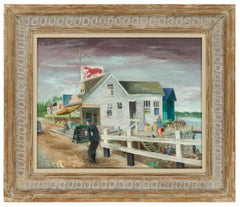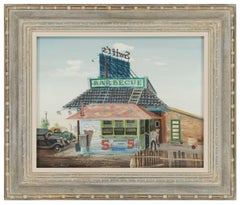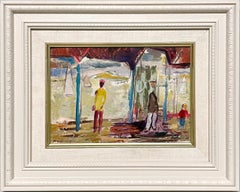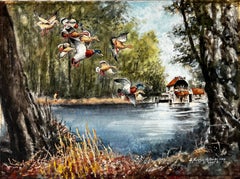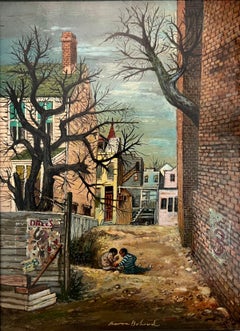Aaron Bohrod Landscape Paintings
American, 1907-1992
Aaron Bohrod's work has not been limited to one style or medium. Initially recognized as a regionalist painter of American scenes, particularly of his native Chicago, Bohrod later devoted himself to detailed still-life paintings rendered in the trompe l'oeil style. He also worked for several years in ceramics and wrote a book on pottery.
Born in 1907, Bohrod began his studies at Chicago's Crane Junior College in 1925, and two years later enrolled in the Art Institute of Chicago. But it was at the Art Students League in New York City, from 1930 to 1932, that he studied under the man believed to be his most significant early influence, John Sloan. Sloan's romantic realism is reflected in the many depictions of Chicago life, which comprised most of Bohrod's early work.
Under Sloan's tutelage, Bohrod came to subscribe to the belief that painters should find the subjects of their art in the immediate world around them. These paintings emphasized architecture unique to north Chicago and featured Chicagoans engaged in such everyday activities as working, playing or going to the theatre. The romantic aspect was conveyed by the use of misty colors, and the realism by attention to detail.
In 1936, Bohrod won the Guggenheim Fellowship award in creative painting. It enabled him to travel the United States, producing similar regionalist paintings on a much broader range of subjects. Nevertheless, most of his early work centered on Chicago and the urban Midwest.
In 1943, Bohrod was commissioned by editors of Life magazine to cover the battlefronts as a war correspondent and artist. Three years later, Bohrod was invited to become the Artist in Residence at the University of Wisconsin, a position that became vacant with the unexpected death of John Steuart Curry. He would remain at the University from 1948 to his retirement in 1973.
Then, quite atypically, fantasy started to appear in his work. Elements of Surrealism, supposedly inspired by his concurrent involvement in ceramics with F. Carlton Ball, began influencing his landscapes. By 1953, Bohrod had completely ceased painting landscapes, turning instead to often symbolic still-life subjects. He abandoned his earlier romantic realism to paint in the luminous trompe l'oeil tradition of William Harnett. Bohrod continued to produce these meticulously crafted fantasies exclusively. While in his position at the University of Wisconsin, Bohrod painted covers for Time magazine and authored two books, A Pottery Sketch-book (1959) and A Decade of Still Life (1966), in which are produced many of his trompe l'oeil paintings.to
2
1
Overall Width
to
Overall Height
to
3
3
1
2
1
3
1
1
1
1
1
1
1
1
1
1
3
2
1
1
1
30
667
598
320
228
3
3
Artist: Aaron Bohrod
"Industrial Cityscape, Chicago" WPA Modernism Mid-Century Cityscape 20th Century
By Aaron Bohrod
Located in New York, NY
"Industrial Cityscape, Chicago" WPA Modernism Mid-Century Cityscape 20th Century
Aaron Bohrod (American 1907 – 1992)
Industrial Cityscape
20 x 16 inches
Oil on board
Signed lower ri...
Category
1930s American Modern Aaron Bohrod Landscape Paintings
Materials
Oil, Board
Oil on Masonite Painting Titled "Lobster Shack", by Aaron Bohrod, 1938
By Aaron Bohrod
Located in New York, NY
Aaron Bohrod, 1907-1992
Lobster Shack, 1938
Oil on masonite
16 x 20 inches
Signed and dated ower left: Aaron Bohrod 1938
Bohrod-3
Provenance:
Private estate, Rhode Island, 2004
Am...
Category
1930s Aaron Bohrod Landscape Paintings
Materials
Masonite, Oil
Gouache on Board Painting Titled "Barbecue Stand", by Aaron Bohrod, circa 1935
By Aaron Bohrod
Located in New York, NY
Aaron Bohrod, 1907-1992
Barbecue Stand, circa 1935
Gouache on board
Signed Lower left: “Aaron Bohrod”
Inscribed and signed on verso
Bohrod-1
Provenance:
Private estate, Rhode Island...
Category
1930s Aaron Bohrod Landscape Paintings
Materials
Gouache
Related Items
A Charming, 1950s Mid-Century Modern Harbor Scene of Martha's Vineyard
By Francis Chapin
Located in Chicago, IL
A Charming, Colorful 1950s Mid-Century Modern Harbor Scene of Martha's Vineyard by Notable Chicago Artist, Francis Chapin (Am. 1899-1965). Painted near the artist's studio and summe...
Category
Mid-20th Century American Modern Aaron Bohrod Landscape Paintings
Materials
Masonite, Oil
$950
H 12.25 in W 12 in D 1.25 in
Flapping Mallard Ducks Dropping Onto The Mill Stream
Located in Cirencester, Gloucestershire
Artist/ School: Norman A.Olley (British, 20th century) dated 1995 and inscribed verso
Title - Mallards Dropping On The Mill Stream
Medium: gouache/water...
Category
19th Century Victorian Aaron Bohrod Landscape Paintings
Materials
Ink, Watercolor, Gouache, Pencil
$652 Sale Price
20% Off
H 11 in W 15 in
Frederick Shane “Twilight of History” 1947 Surrealist Oil Painting, Signed
By Frederick Shane
Located in Denver, CO
"Twilight of History" is a powerful and evocative original oil painting on board by renowned American artist Frederick Shane (1906–1992), created in 1947. This deeply symbolic work e...
Category
1940s American Modern Aaron Bohrod Landscape Paintings
Materials
Oil, Board
$3,750
H 24.5 in W 28.5 in D 2.75 in
Coney Island, Fourth of July
Located in Los Angeles, CA
Coney Island, Fourth of July, c. 1940s, oil on canvas applied to Masonite, signed upper right, 26 x 21 1/2 inches, presented in its original frame
During the 1930s and 40s, Coney I...
Category
1940s American Modern Aaron Bohrod Landscape Paintings
Materials
Board, Oil, Canvas
A Haitian Country Scene
Located in San Francisco, CA
Haitian artist Jacksin Mésidor painted this from his Caribbean coastal hometown of Cap-Haitien in the north of his native land. As Haitian folk art, the painting delivers an archityp...
Category
20th Century Folk Art Aaron Bohrod Landscape Paintings
Materials
Masonite, Oil
Morning Sunrise, Mid Century Laguna Hills Figurative Landscape
Located in Soquel, CA
Beautiful mid century plein air figural landscape of Laguna Niguel, California by an unknown artist (American, 20th Century). The morning sun gli...
Category
1950s American Modern Aaron Bohrod Landscape Paintings
Materials
Canvas, Oil, Cardboard
$719 Sale Price
20% Off
H 20 in W 24 in D 2 in
"Pueblo Indians, Taos, New Mexico" Georgina Klitgaard, Modernist Figures
By Georgina Klitgaard
Located in New York, NY
Georgina Klitgaard
Pueblo Indians, Taos, New Mexico
Signed lower right
Oil on canvas
18 x 24 inches
Georgina Klitgaard’s art has sometimes gotten lost in the critical propensity to...
Category
Mid-20th Century American Modern Aaron Bohrod Landscape Paintings
Materials
Canvas, Oil
$6,000
H 22.625 in W 28.25 in
American West Mountainscape by Gunnar Anderson
Located in New York, NY
Gunnar Donald Anderson (American, 1927-2022)
Untitled, c. 20th Century
Oil on board
Sight: 11 1/2 x 15 3/4 in.
Framed: 20 1/2 x 24 1/2 x 1 1/4 i...
Category
20th Century American Modern Aaron Bohrod Landscape Paintings
Materials
Oil, Board
$2,300
H 20.5 in W 24.5 in D 1.25 in
"A Walk Through the Dunes" - Oil Landscape Painting on Masonite, 2023
Located in Denver, CO
Nanette Fluhr’s "A Walk Through the Dunes" is a captivating landscape painting that brings viewers into the tranquility of a coastal path surrounded by windswept vegetation. This int...
Category
21st Century and Contemporary American Impressionist Aaron Bohrod Landscape Paintings
Materials
Masonite, Oil
Original Antique American Landscape Fishing Delaware River Oil Painting Framed
Located in Buffalo, NY
A lovely scene adeptly painted by listed American artist and illustrator Jan Nosek (1876 - 1966) who was active in the late 19th and early 20th Century. This scene created in the ea...
Category
1910s American Modern Aaron Bohrod Landscape Paintings
Materials
Oil, Board
Night Life in the City - Figurative Cityscape
Located in Soquel, CA
Night Life in the City - Figurative Cityscape
Mid 1960s cityscape by an unknown artist. Oil on artists board.
Image, 16"H x 20"W
Category
1960s American Modern Aaron Bohrod Landscape Paintings
Materials
Canvas, Oil, Illustration Board
$600 Sale Price
20% Off
H 16 in W 20 in D 0.13 in
A Pair of Modern Impressionist Landscape Oil Paintings Framed Female artist NY
Located in Buffalo, NY
A Pair of Modernist Landscapes by listed female artist Margaret Munro Stratton McLennan.
Margaret was a painter working in the early 20th Century in the Syracuse area. These charmi...
Category
1920s American Modern Aaron Bohrod Landscape Paintings
Materials
Oil, Board
$600 Sale Price
20% Off
H 5 in W 7 in
Previously Available Items
"The Kiosk, Lincoln Park Zoo, Chicago" Aaron Bohrod, WPA Midwestern Regionalism
By Aaron Bohrod
Located in New York, NY
Aaron Bohrod
The Kiosk, Lincoln Park Zoo, Chicago, 1932
Signed and dated lower right
Watercolor on paper
17 x 12 inches
Provenance:
The artist
Everett Oehlschlager Galleries, Chicag...
Category
1930s American Realist Aaron Bohrod Landscape Paintings
Materials
Paper, Watercolor
Pittsburgh Alleyway
By Aaron Bohrod
Located in Los Angeles, CA
Pittsburgh Alleyway, c. 1946, oil on gouache on paper on “prestwood” (Masonite), 9 x 12 inches, signed lower middle, Bohrod’s original label verso from his gallery at 4811 Tonyawatha...
Category
1940s American Modern Aaron Bohrod Landscape Paintings
Materials
Mixed Media
Aaron Bohrod landscape paintings for sale on 1stDibs.
Find a wide variety of authentic Aaron Bohrod landscape paintings available for sale on 1stDibs. You can also browse by medium to find art by Aaron Bohrod in paint, oil paint, board and more. Much of the original work by this artist or collective was created during the 20th century and is mostly associated with the modern style. Not every interior allows for large Aaron Bohrod landscape paintings, so small editions measuring 9 inches across are available. Customers who are interested in this artist might also find the work of Simka Simkhovitch, Michael William Eggleston, and Harold Vincent Skene. Aaron Bohrod landscape paintings prices can differ depending upon medium, time period and other attributes. On 1stDibs, the price for these items starts at $5,000 and tops out at $85,000, while the average work can sell for $48,900.

